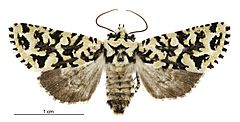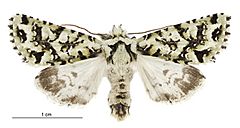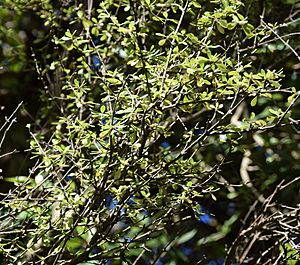Meterana exquisita facts for kids
Quick facts for kids Meterana exquisita |
|
|---|---|
 |
|
| Female | |
 |
|
| Male | |
| Scientific classification | |
| Kingdom: | |
| Phylum: | |
| Class: | |
| Order: | |
| Family: | |
| Genus: |
Meterana
|
| Species: |
M. exquisita
|
| Binomial name | |
| Meterana exquisita (Philpott, 1903)
|
|
| Synonyms | |
|
|
Meterana exquisita is a type of moth that belongs to the Noctuidae family. This special moth lives only in New Zealand. Because it's becoming rare, the Department of Conservation has listed it as "At Risk, Relict." This means it's a unique species that needs our help to survive.
Contents
Discovering the Meterana exquisita Moth
Scientists give names to all living things. This moth was first described in 1903 by a scientist named Alfred Philpott. He called it Melanchra exquisita back then. Philpott found a male moth in a place called West Plains in Southland during December.
Later, another scientist, George Hudson, wrote about and drew this moth in his 1928 book. In 1988, John S. Dugdale moved the moth to a different group, the Meterana genus. This is how scientists sometimes update names as they learn more.
What Does the Meterana exquisita Moth Look Like?
The young moths, called larvae, are quite big. They are green with thin red and white lines. This helps them blend in with the plants they eat.
The adult moths have a wingspan of about 32 millimeters. Their bodies are mostly green. They have black markings that look like a "V" shape on their upper body. Their front wings are bright green with black patterns and white edges. The back wings are a pale yellowish-green. These colors help the moths hide in their natural environment.
Where Does the Meterana exquisita Moth Live?
This moth is endemic to New Zealand. This means it's found nowhere else in the world! It used to live in many parts of New Zealand, including Auckland, Waikato, Taupo, Whanganui, Wairarapa, Nelson, South Canterbury, Mackenzie country, Central Otago, Otago Lakes, and Southland.
Sadly, this moth is now gone from some of its old homes, like West Plains where it was first found. It's also almost disappeared from Auckland.
Life Cycle and Behavior of the Moth
The Meterana exquisita moth has one generation each year. The larvae are bright green, which makes them very good at camouflaging themselves. This helps them hide from predators while they eat their favorite plants.
Larvae eat for about one month. After that, they change into pupae, which is like a resting stage. The adult moths usually fly from August to December. They are most common in September and October. These moths can fly quite far, at least 800 meters, from the plants they need to survive.
What Do Meterana exquisita Moths Eat?
The larvae of this moth eat specific plants. They like small-leaved Olearia species. These include plants like O. hectorii, O. odorata, and O. bullata. These plants are very important for the moth's survival.
Why Is This Moth "At Risk"?
The Meterana exquisita moth is classified as "At Risk, Relict" under the New Zealand Threat Classification System. One big reason for this is that its home is disappearing. When land is developed for buildings or farms, the special plants these moths need are often removed. When their host plants are gone, the moths can't survive in those areas. This has led to them disappearing from many places in New Zealand. Protecting their habitat and the plants they rely on is crucial to help these unique moths survive.


